Rebuilding the Circle: Africa's Conservation Success Stories
The African continent is one of the few remaining places where we can witness the breath-taking range of nature’s diversity. Although 45 percent of the world’s wilderness lies in Africa, the human population is growing at nearly twice the global rate. With a growing population come serious threats to the natural majesty of the continent. From the windy crucible of the Cape to the steaming jungle of the Congo, from the red moonscape of the Kalahari to the blizzards of the Atlas Mountains—totally unique biospheres are disappearing before our eyes.
But the future isn’t hopeless. The tireless efforts of individuals across the continent to turn back the tide of environmental degradation make a difference every day. Here are some inspiring examples of conservation efforts in Africa that are succeeding.
Gorongosa National Park: Gorongosa National Park lies at the southern end of the Great African Rift Valley, in the heart of central Mozambique. Known as “Africa’s lost Eden,” Gorongosa was recently and miraculously brought back from the brink of disappearance. Years of civil war in the country decimated the large mammal population (including hippos, elephants, buffalo, zebra, and lions) by over ninety percent, and ravaged the natural landscape.
But in 2004, the American-based Carr Foundation and the Government of Mozambique teamed up to restore the park. They reintroduced both large mammals and tiny critters, like ants, essential to rebuilding a complete ecosystem, and refurbished Chitengo Safari Camp. Since then, Gorongosa has emerged as one of Africa’s greatest success stories—wildlife is thriving and the park is once again beginning to function as a wonderful place to experience African safari. As E.O. Wilson, one of the world’s most celebrated biodiversity scientists, said, Gorongosa gives us the rare opportunity to “see earth as it looked and felt before the coming of humanity.”
Vamizi Turtle Preservation:
Mozambique’s Vamizi Island is famous for its private resort, its simple luxury, and its unspoilt beaches—but it’s also home to a large population of green and hawksbill turtles, who lay their eggs on the same pristine beaches where we tan and swim. When baby turtles hatch each winter, they immediately begin an arduous trek down to the water’s edge. Turtle survival is already one of nature’s greatest lotteries, made much more difficult by the intervention of humans who poach them for their shells or catch them in fishermen’s nets.
Since 2012, the WWF has been working with Vamizi to stabilize the turtle population. A fulltime staff of nine protects the nests, nurtures hatchlings, spreads the turtle news throughout the local community, and encourages the island’s guests to get involved hands-on.
The plight of the turtles is one of the most compelling and accessible conservation stories on Earth, and as a result, success stories are multiplying. Why not combine a world-class luxury retreat in Vamizi with the life-changing opportunity to watch hatchlings emerge from shells, and nudge them towards survival?
Singita Grumeti Anti-Poaching Unit
Before 2002, illegal poaching across Singita Grumeti in Tanzania, west of the Serengeti, was a daily occurrence. Poaching undermined the tourist potential of the reserves and, in doing so, undermined the ability of local communities to reap sustainable benefits from the area’s rich natural resources.
In 2002, Singita Grumeti Lodge, alongside the Tanzanian Wildlife Division, created an anti-poaching unit to patrol the area, consisting of 120 rangers (many of them ex-poachers) and resulting in unprecedented success. Since the creating of the unit, illegal poaching within Singita Grumeti has been virtually eradicated, and ecotourism is thriving.
Recently, Singita Grumeti has reintroduced black rhino into the reserve, as part of the “Save the Rhino” repatriation initiative, in the hope of revitalizing the population’s numbers and genetic diversity.
Big Life Foundation
Singita Grumeti isn’t the organization that’s successfully tackling poaching in East Africa. The Big Life Foundation, founded in 2010 by photographer Nick Brandt and conservationist Richard Bonham, is dedicated to coordinated cross-border poaching prevention. In its first 22 months of existence, Big Life made 627 arrests and confiscated 1639 weapons in the Amboseli ecosystem across Kenya and Tanzania where Big Life operates. They are successfully protecting 2 million acres on a daily basis with a team of more than 250 rangers—all of whom are hired from local communities.
Since its inception, Big Life has branched out into other, innovative conservation efforts, such as GPS rhino tracking, doggy rangers, a compensation fund for livestock killed by endangered predators, and a Maasai Olympics.
The efforts of these committed conservationists are keeping certain species afloat. But much of their success depends on continued interest in the region, which spurs demand for conservation and makes it financially viable. Tourism is essential to keeping Africa’s biodiversity alive.
By choosing an African safari that engages and explores these issues, you’re choosing to keep the efforts to solve them alive.






